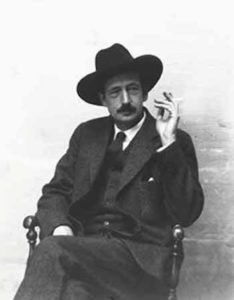
Maynard Dixon
*Maynard Dixon, a white American artist whose work focused on the American West, was born on this date in 1875.
He was born Lafayette Maynard Dixon in Fresno, California, after his maternal grandfather. His family of aristocratic Virginia Confederates had found a new home in California after the American Civil War. His mother, Constance Maynard, a well-educated daughter of a Navy officer from San Francisco, shared her love of classic literature with the young boy and encouraged him in his writing and drawing. His father was Harry St. John Dixon. Young Dixon moved to San Francisco and studied briefly in 1893 at the California School of Design, where he became a close friend of the Tonalist painter Xavier Martinez, with whom he traveled to Monterey, Carmel, and Point Lobos.
In 1900, Dixon visited Arizona and Mexico, and a year later, he accompanied artist Edward Borein on a horseback trip through several western states. He worked as an illustrator for local newspapers and magazines (including the Overland Monthly and Sunset magazine) to ensure a steady income. He illustrated numerous books, such as Clarence E. Mulford’s Hopalong Cassidy. For his first exhibition in the southwest, Dixon contributed four oils to the show of Modern Art from The American West curated at the University of Arizona in Tucson in December of 1912. In 1917, Dixon joined other prominent artists on a committee to redesign the U.S. Army camouflage in order to support America's entry into World War I.
During his long tenure in northern California, he became a prolific contributor to art exhibitions. His first publicized exhibition was a show of “regional artists” in Alameda, California, during the spring of 1899. Thereafter he exhibited at almost every major venue: California Society of Artists (1902); Bohemian Club (1903–1928); San Francisco Art Association (1903–1931); Newspaper Artists League (1903); Press Club (1904); Hotel Del Monte Art Gallery (1907–1909); Panama-Pacific International Exposition (1915); Gump's Gallery (1920 – solo exhibition); San Francisco Print Rooms (1920 – this show was later sent to Honolulu); San Francisco's Don Lee Galleries (1923); Oakland Art Gallery (1926–1928); Galerie Beaux-Arts (1925–1930); Queen Califia in the Room of the Dons at the Mark Hopkins Intercontinental Hotel in San Francisco (1926); the University of California, Berkeley (1928); California State Fair (1928); and Golden Gate International Exposition (1939). In March 1926, he acted as co-curator for an exhibit of “Pueblo and Navajo Arts & Crafts” at the Paul Elder Gallery of San Francisco under the auspices of the Indian Defense Association of Central and Northern California.
Influenced partly by the Panama Pacific International Exposition of 1915, Dixon began to search for a new expression, moving away from impressionism and into a simpler, more modern style. Meeting and marrying Dorothea Lange, a portrait photographer from the east, greatly influenced his art.
They married in 1920, and by 1925, the year their first son was born, Maynard's style had changed dramatically to even more powerful compositions emphasizing design, color, and self-expression. A true modernist emerged. During the Great Depression, Dixon painted a series of social realism canvases depicting the prevailing politics of maritime strikes, displaced workers, and those affected by the Depression. Simultaneously, Lange captured on film images of the migrant workers in the Salinas Valley and the city breadlines, images that eventually brought her fame.
During the summer of 1931, he exhibited at the Tahoe Tavern on Lake Tahoe. For a time, he lived in New York with his young wife and baby daughter Constance but soon returned to the western United States, where he said he could create "honest art of the west" instead of the romanticized versions he was being paid to create. In 1933, the Dixons spent the summer in Zion National Park with vacations to the hamlet of Mount Carmel, Utah. His first marriage ended shortly after he began a new life in San Francisco. Lange was called back to San Francisco, a separation that led to the couple's divorce in 1935.
Dixon is considered one of the finest artists who dedicated most of their art to the U.S. southwestern cultures and landscapes at the end of the nineteenth century and the first half of the twentieth century.
Two years later, Dixon married San Francisco muralist Edith Hamlin. The couple left San Francisco two years later for southern Utah, the source of some of Dixon's greatest art. In 1939, the couple built a summer home in Mount Carmel, where Dixon found new friends and became reacquainted with the local natural landscapes. He lived near the cottonwood trees along an old irrigation ditch and took short hikes to a plateau where he loved the quiet. Dixon spent winter months in Tucson, where the couple also had a home and studio. He continued to create simple but powerful compositions in which non-essential elements were distilled or eliminated.
Maynard Dixon died on November 11, 1946, in Tucson. In the spring of 1947, his widow Edith brought his ashes to Mount Carmel, where she buried them on a high bluff above the art studio being built on the property. This had been at his request, and she felt it a fitting tribute where friends could come to pay respects and view the land he loved.